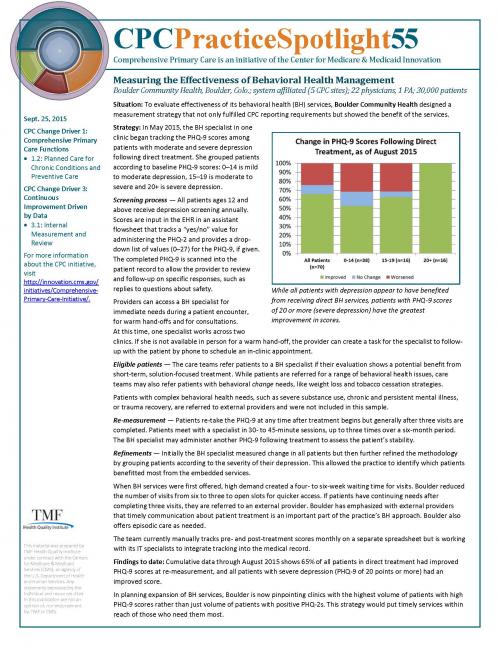
Measuring the Effectiveness of Behavioral Health Management
Boulder Community Health, Boulder, Colo.; system affiliated (5 CPC sites); 22 physicians, 1 PA; 30,000 patients
CPC Change Driver 1: Comprehensive Primary Care Functions - 1.2: Planned Care for Chronic Conditions and Preventive Care
CPC Change Driver 3: Continuous Improvement Driven by Data - 3.1: Internal Measurement and Review
Situation: To evaluate effectiveness of its behavioral health (BH) services, Boulder Community Health designed a measurement strategy that not only fulfilled CPC reporting requirements but showed the benefit of the services.
Strategy: In May 2015, the BH specialist in one clinic began tracking the PHQ-9 scores among patients with moderate and severe depression following direct treatment. She grouped patients according to baseline PHQ-9 scores: 0–14 is mild to moderate depression, 15–19 is moderate to severe and 20+ is severe depression.
While all patients with depression appear to have benefited from receiving direct BH services, patients with PHQ-9 scores of 20 or more (severe depression) have the greatest improvement in scores.
Screening process — All patients ages 12 and above receive depression screening annually. Scores are input in the EHR in an assistant flowsheet that tracks a “yes/no” value for administering the PHQ-2 and provides a drop-down list of values (0–27) for the PHQ-9, if given. The completed PHQ-9 is scanned into the patient record to allow the provider to review and follow-up on specific responses, such as replies to questions about safety.
Providers can access a BH specialist for immediate needs during a patient encounter, for warm hand-offs and for consultations. At this time, one specialist works across two clinics. If she is not available in person for a warm hand-off, the provider can create a task for the specialist to follow-up with the patient by phone to schedule an in-clinic appointment.
Eligible patients — The care teams refer patients to a BH specialist if their evaluation shows a potential benefit from short-term, solution-focused treatment. While patients are referred for a range of behavioral health issues, care teams may also refer patients with behavioral change needs, like weight loss and tobacco cessation strategies.
Patients with complex behavioral health needs, such as severe substance use, chronic and persistent mental illness, or trauma recovery, are referred to external providers and were not included in this sample.
Re-measurement — Patients re-take the PHQ-9 at any time after treatment begins but generally after three visits are completed. Patients meet with a specialist in 30- to 45-minute sessions, up to three times over a six-month period. The BH specialist may administer another PHQ-9 following treatment to assess the patient’s stability.
Refinements — Initially the BH specialist measured change in all patients but then further refined the methodology by grouping patients according to the severity of their depression. This allowed the practice to identify which patients benefitted most from the embedded services.
When BH services were first offered, high demand created a four- to six-week waiting time for visits. Boulder reduced the number of visits from six to three to open slots for quicker access. If patients have continuing needs after completing three visits, they are referred to an external provider. Boulder has emphasized with external providers that timely communication about patient treatment is an important part of the practice’s BH approach. Boulder also offers episodic care as needed.
The team currently manually tracks pre- and post-treatment scores monthly on a separate spreadsheet but is working with its IT specialists to integrate tracking into the medical record.
Findings to date: Cumulative data through August 2015 shows 65% of all patients in direct treatment had improved PHQ-9 scores at re-measurement, and all patients with severe depression (PHQ-9 of 20 points or more) had an improved score.
In planning expansion of BH services, Boulder is now pinpointing clinics with the highest volume of patients with high PHQ-9 scores rather than just volume of patients with positive PHQ-2s. This strategy would put timely services within reach of those who need them most.
Comprehensive Primary Care is an initiative of the Center for Medicare & Medicaid Innovation
For more information about the CPC initiative, visit https://innovation.cms.gov/innovation-models/comprehensive-primary-care-initiative.
This material was prepared by TMF Health Quality Institute under contract with the Centers for Medicare & Medicaid Services (CMS), an agency of the U.S. Department of Health and Human Services. Any statements expressed by the individual and resources cited in this publication are not an opinion of, nor endorsement by, TMF or CMS.
| Attachment | Size |
|---|---|
| 245.97 KB |
